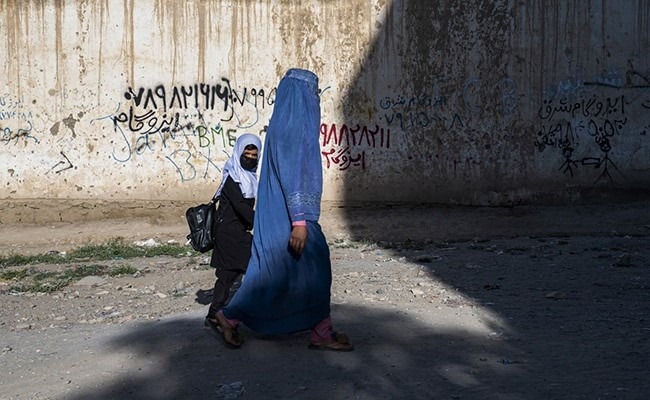| Translate This News In |
|---|
The overcrowded wards of a run-down clinic in southern Afghanistan are just one indicator of the devastating humanitarian crisis that has gripped the war-torn country since the Taliban retook power a year ago.
Last month, the Musa Qala District Hospital in Helmand province was compelled to close its doors to all but patients suffering from probable cholera.
The infirmary quickly became clogged with listless patients, intravenous drips needled into their wrists as they rested on rusty gurneys.
Despite the clinic’s lack of testing facilities for cholera, approximately 550 patients showed themselves within days, displaying symptoms of a disease caused by a lack of fundamental sanitation needs: clean drinking water and an effective sewerage system.
“It’s incredibly challenging,” hospital chief Ehsanullah Rodi, who has been running on only five hours of sleep each night since the inflow began, told AFP.
“We didn’t see this last year or any previous year.”
According to the United Nations, Afghanistan’s humanitarian catastrophe is the worst in the world.
Children who are starving
Poverty in the country has reached dire new heights, aggravated by drought and inflation since Russia’s invasion of Ukraine.
Many of the beds on the malnutrition ward are occupied by two tiny, fragile patients, some suckling gamely on syringes of milk, while others heave onerous breaths as they struggle to restore their strength.
“We can’t even buy dry bread,” said Breshna, the mother of another sufferer, who estimates her daughter’s age to be between 15 and 20.
“We haven’t eaten anything in three or four days.”
Assistant nursing supervisor Homeira Nowrozi, struggling to be heard above sobbing infants, stated that workers “had no rest.”
“We have a lot of patients who come in critical,” she said, explaining that parents could not afford to go sooner.
A moral tangle
Afghanistan’s plight began long before August 15, 2021, when the Taliban captured Kabul following a hasty retreat of US-led soldiers and the collapse of the government they backed up.
The Taliban’s takeover, however, pushed the country of 38 million people over the edge.
The United States froze $7 billion in central bank assets, the formal banking sector collapsed, and foreign aid totaling 45 percent of GDP was suspended overnight.
Over the past year, potential donors have struggled with the dilemma of channelling new funds to the ailing nation, which the Taliban rebranded the “Islamic Emirate” in accordance with their austere theocratic views.
“How do you provide aid in a country when you don’t recognise the government?” wondered Roxanna Shapour of the Afghanistan Analysts Network.
Importing humanitarian supplies to handle catastrophes like as the June earthquake, which killed over 1,000 people and displaced tens of thousands more, is very simple, she added, because it is “non-political, life-saving help.”
Cash is also airlifted to support food relief and healthcare, but development aid for long-term projects that could reshape the economy is more complicated.
“That’s fantastic if you go in and say, “I’m going to pay all teacher wages.” But what will the Taliban do with the money they save by not having to pay teacher salaries?” Shapour enquired.
A sour mood
The destitution is palpable in Musa Qala, a dusty rural town with a shipping container mart populated by juvenile shopkeepers.
The small economy appears to rely on motorbike maintenance, the selling of pale poultry carcasses, and canisters of energy drinks kept tepid in filthy chest freezers.
The village witnessed some of the deadliest episodes of the 2001-2021 conflict and is linked to Lashkar Gah by a makeshift track up a dry riverbed surrounded with jagged rocks.
In a tragic irony, the emergence of peace has only increased despair and the demand for humanitarian services.
“Now we can go to the hospital at any time of day or night,” said Maimana, whose eight-year-old daughter Asia was being treated at Musa Qala.
According to Helmand Public Health Director Sayed Ahmad, the influx of additional patients means “less room” and “fewer staff, thus there are issues.”
Nonetheless, Ahmad, a soft-spoken doctor whose office is piled high with medical books, argues that “the general situation is better” than it was under the previous administration, when corruption was rampant.
He blames some of the Taliban’s issues on economic sanctions, claiming that “people’s needs and demands have escalated.”
Analysts, however, argue that Islamists are not entirely blameless.
“The Taliban’s oppressive social policies have made it more difficult to achieve an agreement on releasing those frozen assets,” said Graeme Smith of the International Crisis Group.
Unable to govern
The Taliban banner is now publicly displayed over Helmand province, affixed to bullet-riddled houses.
But, after two decades of lusting for power, they now rule a country in shambles.
One man in Lashkar Gah, who did not want to be identified, made his own critical statement on the Taliban’s ability to rule.
“The government’s garments are too big for them,” he explained.


















